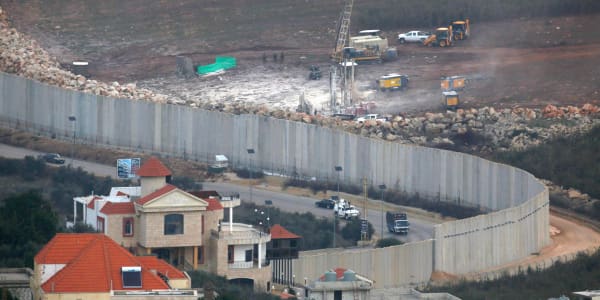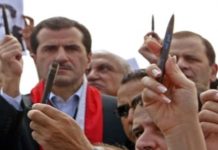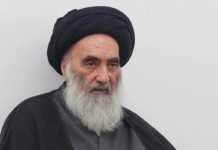Home تعليقات ومقالات مميزة الياس حرفوش/هل يقفل ترسيم الحدود دكان المقاومة؟/Elias Harfoush: Will Drawing Border Demarcation...
هل يقفل ترسيم الحدود دكان المقاومة؟
الياس حرفوش/الشرق الأوسط/08 تشرين الأول/2020
Will Drawing Border Demarcation Put an End to the Resistance Charade?
Elias Harfoush/Asharq Al Awsat/October 10/2020
Let us imagine for a moment that another Lebanese official, other than Speaker Nabih Berri, who is not allied with the “resistors” and “objectionists,” stood up to announce that an understanding had been reached, through the United States, to initiate negotiations with Israel. The answer is that this person would be considered a traitor, and it suffices to demonstrate the balance of power in Lebanon, and who actually holds the keys to war and peace in this unfortunate country and can use them whenever it sees fit and under whatever conditions it decides.
All of a sudden, sitting at the same table with the Israelis in Naqoura has become patriotic. The United States’ sponsorship of these negotiations, rather, its bid to “help establish and maintain a positive and constructive atmosphere between the two parties,” is a requisite to furthering Lebanon’s interest! What is meant by the “two parties”, of course, is Lebanon and Israel, which, in “objectionist” literature, is referred to as the “Israeli entity” sometimes and the “Zionist entity” at other times, although neither of these terms were mentioned in the agreement that Berri signed and read out to the media.
Covering this matter up required a systematic media makeover to ameliorate the mission. It was said, for example, that Berri’s initiative has nothing to do with the threat of US sanctions, which targeted his political aide, former minister Ali Hassan Khalil. Berri himself said that the agreement over a framework had been reached before the sanctions’ announcement, but it is obvious that “openness” to the US facilitation of the negotiation process will be positively received by an American administration known for its fondness for tributes to its roles in resolving intractable crises.
The media at hand has also repeatedly been referring to “indirect negotiations” in Naqoura. This is all to say that the “objectionists” who will oversee the negotiation process – despite claims that the matter will be handed to the Lebanese president and the Army Command- will not be sitting “directly” with the Israelis. They must have a different interpretation of the term “direct” than that with which we are familiar. Even with the negotiations being conducted through an intermediary, who is described as the “Great Satan” anyway, how else could one describe sitting with another person in the same room, talking to him and listening to his positions?
All of this compels us to say that raising the cause of the southern border and the relationship with Israel has always been meant for use in the Lebanese political bazaar and has nothing to do with Lebanon’s real interests.
The first Article of the armistice agreement reached between Lebanon and Israel in 1949 stipulates the following:
The following principles, which shall be fully observed by both Parties during the armistice, are hereby affirmed:
The injunction of the Security Council against resort to military force in settlement of the Palestine question shall henceforth be scrupulously respected by both Parties. No aggressive action by the armed forces – land, sea or air – of either Party shall be undertaken, planned, or threatened against the people or the armed forces of the other; it being understood that the use of the term “planned” in this context has no bearing on normal staff planning as generally practiced in military organizations. The right of each Party to its security and freedom from fear of attack by the armed forces of the other shall be fully respected.”
One does not need to conduct a thorough revision of Lebanese history to determine how Lebanon has dealt with this agreement. First, it allowed Palestinian organizations to operate in the south (the 1970 Cairo Agreement), with the Lebanese parliament legalizing this and carving out a part of this territory, openly referred to as “Fatah Land” as grounds from which the organizations could carry out their operations from the borders of Lebanon. At the time, this legislation was passed for no other reason than to serve internal electoral interests, both presidential and parliamentary. Afterward, the National Movement rallied around the Palestinian resistance’s activities during the Lebanese civil war to further the same political interests and exploit this activity to impose a new political reality and power balance. This pursuit ended with the amendments made to the Lebanese constitution that ended the war.
The war ended with a new political reality in Lebanon. It also ended, however, with a new reality in the south, manifested in Israel’s occupation of part of Lebanon’s territory. Here, too, politics and internal interests came into play, preventing any communication or mediation that would allow for the armistice agreement’s restoration, which could have paved the way for Israel’s withdrawal in exchange for the cessation of the operations conducted against it from Lebanon, as stipulated by this agreement. Nothing of the sort happened. Indeed merely proposing something along these lines was taboo. Instead, bringing about liberation was entrusted to a single party that would act as it pleased, per its internal interests and those of its regional sponsor, Iran. No party or political entity in Lebanon could question the tripartite slogan (the army, the people, and the resistance).
The resistance led to the Israeli forces’ exit from Lebanon in May 2000. This could have been a chance for turning the black page that cost the Lebanese their youth’s blood and destroyed villages and regions in the south. However, Hezbollah’s interests and the preservation of its influence and weapons dictated new reasons that would allow for politically investing in resistance slogans domestically. Here, the “objectionists” recalled a small chunk of Lebanese territory called the Shebaa Farms, which had been occupied by Israel since 1967 and has nothing to do with the Israeli occupation of the southern territory covered by Security Council Resolution 425, from which Israel withdrew. Its area is no larger than 200 square kilometers.
Solving the Shebaa problem and restoring Lebanese sovereignty has nothing to do with Israel; in fact, it requires the cooperation of Hezbollah’s friends in Damascus.
In 2000, the Lebanese authorities sent to the United Nations a 1966 map indicating that this area was within Lebanon’s borders. The UN responded as follows: “The United Nations has ten other maps issued after 1996 by Lebanese governmental institutions, including the Ministry of Defense and the Army, all of which place farms inside the Syrian Arab Republic. The United Nations has also studied six maps issued by the Syrian Arab Republic’s government, including three maps dating back to 1966 that indicate that the farms are located inside the Syrian Arab Republic.”
When the Security Council discussed the implementation of Resolution 1701 issued after the 2006 war, then Secretary-General Kofi Annan emphasized that the solution to the Shebaa Farms question requires a Lebanese-Syrian agreement regarding the demarcation of the international borders they share.
Here we arrive at the other segment of the demarcation process, the land border. If the Lebanese and Israeli delegations reach an agreement on the demarcation of the maritime borders, it could pave the way for resolving their land border differences, which the two sides say are minor. Will that open the door to settling the pending border issues with Syria, including Syrian regime affirmation to the UN that the Shebaa Farms is Lebanese territory, an issue which Bashar al-Assad’s regime refuses to discuss? Or will it be easier to resolve border disputes with Israel than it is with Syria?
Will this put an end to the abuse of sovereignty and borders, and will Hezbollah become a Lebanese political party that does not raise self-righteous slogans about resistance and liberation?
هل يقفل ترسيم الحدود دكان المقاومة؟
الياس حرفوش/الشرق الأوسط/08 تشرين الأول/2020
لنتخيَّل لبرهةٍ لو أنَّ مسؤولاً لبنانياً آخرَ، غير الرئيس نبيه بري، من خارج القوى التي تعتبر نفسها «ممانعة ومقاومة»، وقف يعلن التفاهمَ عبر الولايات المتحدة على بدء مفاوضات مع إسرائيل. يكفي الجواب، الذي سيضع من يتصدَّى لعمل كهذا في خانة الخيانة، ليؤكّد كيف صار توازن القوى في لبنان، ومن يملك المفاتيح الحقيقية للحرب والسلم في تلك البلاد التعيسة، متى يشاء وبالشروط التي يشاء. فجأة صار الجلوس مع الإسرائيليين على طاولة واحدة في الناقورة عملاً وطنياً. وصارت رعاية الولايات المتحدة لمفاوضات كهذه، بل دعوتها إلى «المساعدة على تأسيس جو إيجابي وبنَّاء مع الطرفين والمحافظة عليه»، مسألة تقتضيها مصلحة لبنان! والمقصود بالطرفين طبعاً: لبنان وإسرائيل، التي تسمى في أدبيات الممانعين مرة «الكيان الإسرائيلي» ومرة أخرى «الكيان الصهيوني»، مع أنَّ أياً من هذه التعابير لم يرد في نص الاتفاق الذي وافق عليه الرئيس بري وقرأه أمام الإعلام.
للتغطية على الأمر، كانت هناك حاجة إلى عملية ماكياج منظمة عبر وسائل الإعلام التي تحسن هذه المهمة. قيل مثلاً في هذا السياق إنَّ مبادرة الرئيس نبيه بري لا علاقة لها بالتهديد بالعقوبات الأميركية، التي طالت معاونه السياسي الوزير السابق علي حسن خليل. بري نفسه قال إن اتفاق الإطار تم التوصل إليه قبل إعلان العقوبات، لكن الواضح أن «الانفتاح» على الدور الأميركي في تسهيل عملية التفاوض سيلاقي صدى إيجابياً لدى إدارة أميركية معروفة بحبها للإشادة بأدوارها في حل الأزمات المستعصية.
جرى كذلك، عبر وسائل الإعلام التي نتحدث عنها، تكرار الحديث عن «مفاوضات غير مباشرة» في الناقورة. وكل ذلك للقول إن «الممانعين» الذين سيشرفون على عملية التفاوض، رغم القول بنقل الملف إلى الرئيس اللبناني وقيادة الجيش، لا يجلسون «مباشرة» مع الإسرائيليين. ولا بدَّ أن يكون لدى هؤلاء تفسير آخر لعبارة «مباشرة» غير الذي نعرفه. إذ كيف يوصف الجلوس مع شخص آخر في غرفة واحدة والتحدث إليه، والاستماع إلى مواقفه، ولو عبر وسيط موصوف في كل الأحوال بـ«الشيطان الأكبر»؟
كل ذلك يجرنا إلى القول إن قضية الحدود الجنوبية والعلاقة مع إسرائيل كانت دائماً في لبنان مادة تُستخدم في بازار المتاجرة الداخلية، ولا علاقة لها في حقيقة الأمر بالمصلحة اللبنانية الفعلية.
بين لبنان وإسرائيل اتفاقية هدنة مبرمة منذ عام 1949، تنص في مادتها الأولى على:
«يتعهد الجانبان اللبناني والإسرائيلي من الآن فصاعداً التقيد بدقة بالأمر الصادر عن مجلس الأمن بعدم اللجوء إلى القوة العسكرية لتسوية قضية فلسطين، وبامتناع الجانبين عن اتخاذ أي عمل عدائي ضد شعب الجانب الآخر أو قواته، أو إعداد مثل هذا العمل أو التهديد به. كما تنص على أن يُحترَم احتراماً كاملاً حق كل طرف في أمنه وحريته من الخوف من هجوم تشنه عليه قوات الجانب الآخر المسلحة». لا يحتاج المرء إلى مراجعة بعيدة في صفحات التاريخ ليتبيَّن له كيف تعاطى لبنان مع نص هذا الاتفاق، أولاً من خلال سماحه بنشاط المنظمات الفلسطينية في الجنوب، (اتفاق القاهرة عام 1970) التي شرّع لها مجلس النواب اللبناني اقتطاع جزء من تلك الأرض أُطلق عليه صراحة اسم «فتح لاند» لممارسة نشاطها من حدود لبنان. لم يكن ذلك التشريع في ذلك الوقت إلا لمصالح انتخابية داخلية، رئاسية ونيابية، وجاء بعده الالتفاف حول نشاط المقاومة الفلسطينية تحت شعارات «الحركة الوطنية» خلال الحرب الأهلية اللبنانية للأغراض السياسية نفسها ولاستغلالها لفرض واقع سياسي جديد وتوازنات قوة جديدة، انتهت إلى التعديلات التي حصلت في الدستور اللبناني بهدف إنهاء تلك الحرب.
انتهت الحرب بواقع سياسي جديد في لبنان. لكنها انتهت أيضاً في حين الواقع الجديد في الجنوب كان يفرض نفسه على البلد، متمثلاً بالاحتلال الإسرائيلي لجزء من الأرض اللبنانية. هنا أيضاً دخلت السياسة والمصالح الداخلية على الخط لمنع أي اتصال أو وساطة تسمح بعودة العمل بنصوص اتفاقية الهدنة، ما كان يمكن أن يمهد لانسحاب إسرائيل في مقابل وقف العمليات ضدها من لبنان كما تنص تلك الاتفاقية. لم يحصل شيء من ذلك، بل كان من المحرّمات أن يطرح شيء من هذا القبيل. بدلاً من ذلك تم تلزيم عملية التحرير لحزب واحد يتصرف بها كما يشاء، بحسب ما تفرض مصالحه الداخلية ومصالح إيران، راعيته الإقليمية. وكان الشعار الثلاثي الذي مُنع على أي حزب أو جهة سياسية في لبنان مناقشته (الجيش والشعب والمقاومة).
أفضت المقاومة إلى خروج القوات الإسرائيلية من لبنان في مايو (أيار) 2000. وكان يمكن أن يكون ذلك بمثابة عملية طي لتلك الصفحة السوداء التي كلفت اللبنانيين دماء شبابهم ودمار عدد من قراهم ومناطقهم الجنوبية، لكن مصلحة «حزب الله» والمحافظة على نفوذه وسلاحه كانت تقتضي اختراع أسباب جديدة للمضي في استثمار شعارات المقاومة على الساحة السياسية الداخلية. هنا تذكر «الممانعون» قطعة من الأرض اللبنانية تدعى مزارع شبعا. أرض صغيرة محتلة من جانب إسرائيل منذ عام 1967، أي لا علاقة لها بالاحتلال الإسرائيلي لأراضي الجنوب المشمولة بقرار مجلس الأمن رقم 425، والتي انسحبت منها إسرائيل.، مساحتها في حدود 200 كلم مربع.
حل مشكلة شبعا واستعادتها للسيادة اللبنانية لا علاقة لها بإسرائيل، بل حلّها يفترض تعاوناً من أصدقاء «حزب الله» في دمشق.
في عام 2000 أرسلت السلطات اللبنانية إلى الأمم المتحدة خريطة مؤرخة في عام 1966 تشير إلى أن هذه المزارع كانت تقع داخل حدود لبنان. وجاء رد الأمم المتحدة كما يلي:
«في حوزة الأمم المتحدة 10 خرائط أخرى أصدرتها بعد عام 1996 مؤسسات حكومية لبنانية، منها وزارة الدفاع والجيش، وجميعها تضع المزارع داخل الجمهورية العربية السورية. وقد قامت الأمم المتحدة أيضاً بدراسة ست خرائط أصدرتها حكومة الجمهورية العربية السورية، منها ثلاث خرائط تعود إلى عام 1966، تضع المزارع داخل الجمهورية العربية السورية».
وعندما بحث مجلس الأمن مسألة تطبيق القرار 1701، الذي تم التوصل إليه بعد حرب 2006، أكد الأمين العام آنذاك كوفي أنان أن حل قضية مزارع شبعا تحتاج إلى اتفاق لبناني – سوري بشأن ترسيم الحدود الدولية بينهما.
وهنا نصل إلى الجزء الآخر من عملية ترسيم الحدود، المتعلق بالحدود البرية. فإذا توصل الوفدان اللبناني والإسرائيلي إلى اتفاق على ترسيم الحدود البحرية، يمكن أن يمهد الطريق لحل الخلافات على الحدود البرية، التي يقول الطرفان إنها خلافات طفيفة، هل يفتح ذلك الباب أمام تسوية مسائل الحدود العالقة مع سوريا، التي يرفض نظام بشار الأسد مناقشتها، بما يتضمن تأكيداً من النظام السوري للأمم المتحدة أن مزارع شبعا أرض لبنانية؟ أم سيكون حل الخلافات الحدودية مع إسرائيل أسهل من حلها مع سوريا؟
وهل يساعد ذلك على إقفال ملف المتاجرة بالسيادة والحدود، ويعيد «حزب الله» حزباً سياسياً لبنانياً، لا يستمر في المزايدة على سواه بشعارات الممانعة والتحرير؟






















